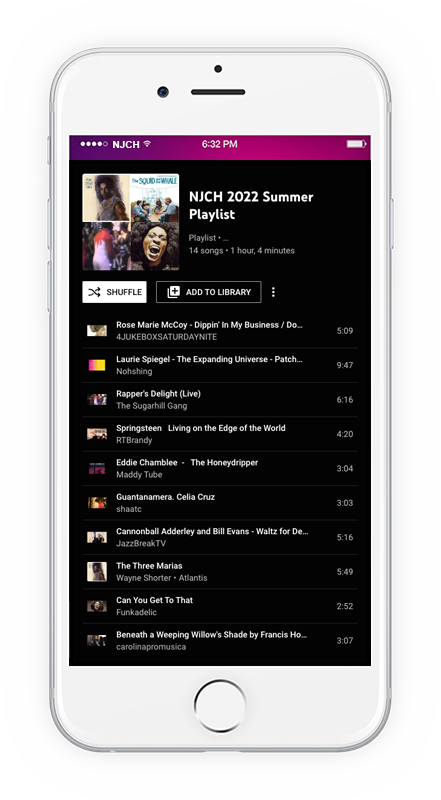1. Rose Marie McCoy, "Dippin' In My Business"
Arkansas-born Rose Marie McCoy co-wrote "Dippin' In My Business" with her favorite writing partner, Charlie Singleton. It was released by Cat Records in 1954. Rose was 31 or 32 years old, just beginning to really make it as a songwriter, and still hoping for a career as a singer. By the very next year, she was successful enough to buy her own house in Teaneck, New Jersey, where she lived for the next 60 years.
"Dippin' In My Business" tells the story of a young independent woman who is enjoying her life—and who doesn't want to be judged for it! I imagine Rose walking down the street, full of joy after a late night with fellow musicians, getting some looks from passerby—then turning it into a song, as she did with so many of her experiences in life. This rare release deserves to be better known.
-Susan Wallner, Producer, PCK Media
2. Laurie Spiegel, “Patchwork”
Bell Telephone Labs in New Jersey is famous for technology that has profoundly impacted our day-to-day lives, such as the transistor circuit which made consumer electronics possible. Perhaps less well-known is that Bell had a significant impact on the development of electronic music, beginning with the creation in the 1950s of one of the first computer programs designed to generate music.
Spiegel’s 1980 album The Expanding Universe contains compositions created at Bell during the 1970s, and it shows her skills as a female pioneer of electronic music. Inspired by banjo music, this piece of sunny electronic minimalism is perfect for relaxing on a hot summer day.
-James Kirkland, Program Officer, NJCH
3. The Sugarhill Gang, “Rapper’s Delight”
Yes, that’s right, hip hop’s first commercial hit from 1979 has New Jersey roots. Trailblazers Mike Wright (Wonder Mike), Henry Jackson (Big Bank Hank), and Guy O’Brien (Master Gee) of The Sugarhill Gang all hailed from Englewood.
-James Kirkland, Program Officer, NJCH
4. Bruce Springsteen, “Living on the Edge of the World”
[NJCH staff note: come on, we had to include him!]
In "Living on the Edge of the World," Springsteen memorializes a quintessential New Jersey activity: driving on the NJ Turnpike. Many lyrics from this 1979 outtake from The River make their way into "Open All Night" on Nebraska, but "Living on the Edge of the World" gives us topography that is closer to 1970s NJ reality, in particular by name checking Howard Johnson's ("HoJo"), which was the exclusive food service provider on the Turnpike until 1973. Other Turnpike features Springsteen mentions, such as refineries and radio towers (and, of course, a speed trap!), are still familiar to New Jersey motorists today.
-Prudence Jones, Associate Professor, Montclair State University
5. Al Griffin, “The Honeydripper”
Asbury Park’s Springwood Avenue has been called "Little Harlem" and the Main Street of Asbury Park's west side community. Framed within the popular genres of gospel, jazz, and rhythm and blues, Springwood thrived as an enclave of African-American musical expression. Throughout the streets on any given night, from one of the many famous clubs that dotted its strip, listeners could hear the musical sounds of icons such as Billie Holiday, Ella Fitzgerald, Duke Ellington, and Count Basie. But these clubs were only the start of a larger musical springboard that expanded throughout the entire West Side, with local musicians serenading the rest of the town from their backyard to their front porch.
One of these local musicians is Al Griffin, a drummer who was born in 1929 in the apartment above his family business on Springwood Avenue in Asbury Park, New Jersey. At age fourteen, he started playing the drums and began performing with local musicians such as Dee Holland and Cliff Johnson on Springwood Avenue. He performed all over the world with musicians such as Dinah Washington, Milt Buckner, and Eddie Chamblee at venues such as the Apollo Theater (NYC) and the Fontainebleau (Miami, FL). Find out more about Al and listen to the Asbury Park African-American Music Project’s interview with him here: https://www.asburyamp.org/people/#algriffin.
-Jennifer Souder, President, Asbury Park African-American Music Project
6. Celia Cruz, “Guantanamera”
Respect the Queen (of Salsa). Born in Cuba, Celia Cruz performed all around the globe and recorded dozens of albums and songs throughout her groundbreaking career. She became a US citizen and settled in Fort Lee following Fidel Castro’s rise to power and the Cuban Revolution in 1959.
Her legacy as a musician and an icon of Afro-Latinidad has been enshrined in cultural scholarship, art (check out ceramicist Roberto Lugo’s homage to her in his current exhibition at NJCH grantee Grounds for Sculpture), and landmarks around the world, including a park in Union City and a rest stop on the Garden State Parkway in Forked River. “Guantanamera,” which is based upon the poetry of José Martí, remains one of Cruz’s most beloved songs. Azúcar!
-Valerie Popp, Director of Strategic Initiatives, NJCH
7. Bill Evans with Cannonball Adderley, “Waltz for Debby”
Bill Evans is often regarded as one of the most influential pianists in jazz history, but many forget that he was a New Jersey native, growing up in North Plainfield and graduating from North Plainfield High School in 1946 before following his older brother to Louisiana for college.
“Waltz for Debby” is one of Bill’s most famous compositions, and this particular recording pairs him with alto virtuoso Cannonball Adderley on Adderley’s record “Know What I Mean?” which features Percy Heath on bass and Connie Kay on drums. The song starts as a waltz but eventually finds its way to a more familiar 4/4 swing feel, making it a bit different from some of Bill’s other famous versions of the same song.
-Neal Day, Operations Manager and Melissa Walker, Founder & President, Jazz House Kids
8. Wayne Shorter, “The Three Marias”
Saxophonist and composer Wayne Shorter is one of Newark’s more famous cultural heroes, but his body of work is so large and broad that there is always more to discover. “The Three Marias” is from Wayne’s 1985 album “Atlantis,” his first studio album as a leader in 11 years. It was inspired by three Portuguese writers who were arrested for what was deemed obscene work, who were pushing into new areas artistically.
Wayne has always been an advocate for exploring the unknown and pushing limits, and this composition, which is more heavily through-composed than improvised, charts the long journey these women made that eventually led to their exoneration. On top of its political significance, the song is a total bop with its infectious bass line.
-Neal Day, Operations Manager and Melissa Walker, Founder & President, Jazz House Kids
9. Funkadelic, “Can You Get To That”
This pioneering funk band, along with its counterpart group Parliament, was formed in Plainfield, NJ in the 1960s. Known for their accomplished musicianship and flamboyant live shows, the groups’ combined musical output had a significant influence on funk, hip-hop, and other modern musical styles.
-James Kirkland, Program Officer, NJCH
10. Francis Hopkinson, “Beneath a Weeping Willow’s Shade”
Francis Hopkinson was one of New Jersey’s Five Signers of the Declaration of Independence, as well as an inventor, designer, poet, musician, and composer. His “Beneath a Weeping Willow’s Shade” is taken from the collection Seven Songs for the Harpsichord or Forte Piano, with all words and music composed by him. The collection was dedicated to George Washington.
-John Burkhalter, Artistic Director, The Practitioners of Musick
11. Whitney Houston, “The Star-Spangled Banner”
That voice. That headband. That magisterial 4/4 arrangement of a familiar 3/4 time piece. Newark-born Whitney Houston’s rendition of “The Star-Spangled Banner” at Super Bowl XXV in 1991 set a new bar for our national anthem. If you’re curious to read more about her performance, I recommend Danyel Smith’s "When Whitney Hit the High Note," first published by ESPN in 2016; it’s a tour de force of music criticism that interweaves the show’s historical context—the Gulf War, the racial politics of Black performance onstage and on the Astroturf—with the story of Houston’s all-too-brief life.
-Valerie Popp, Director of Strategic Initiatives, NJCH
12. John Phillips, “Holland Tunnel”
Phillips, of The Mamas & the Papas fame, was not from NJ—but few things have as strong an association with NJ as traffic. This song is about traveling from NJ to NY via the Holland Tunnel. It’s an experience many of us know all too well.
-James Kirkland, Program Officer, NJCH
13. James Price Johnson, “Charleston”
James Price Johnson was born on February 1, 1894 in his parents’ home at 6 City Alley, New Brunswick, New Jersey. He composed a plethora of songs that came to be standards in the jazz repertory. His most famous composition, “Charleston,” became the theme song to the Roaring Twenties.
-Michael Conklin, Scholar in Departments of Music and African-American Studies, The College of New Jersey
14. Yo La Tengo, Saturday
A quintessential indie rock band, formed in Hoboken in the 1980s and still active. The song is anchored by a repetitive drum machine beat, dub-inflected bass line, and droning organ while periodic swatches of percussion, piano, and guitar provide color. While not as sunny as other selections, it evokes the soundscape that accompanies a late summer night in North Jersey.
-James Kirkland, Program Officer, NJCH
NJCH is immensely grateful to the partners and grantees above for sharing their ideas. Happy listening and enjoy the rest of the summer!
-Valerie Popp, Director of Strategic Initiatives
Beach radio photo by Ron Lach / Pexels


